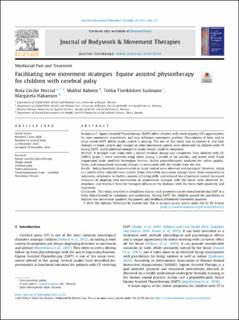| dc.contributor.author | Norrud, Brita Cecilie | |
| dc.contributor.author | Råheim, Målfrid | |
| dc.contributor.author | Sudmann, Tobba Therkildsen | |
| dc.coverage.spatial | Norway | en_US |
| dc.date.accessioned | 2021-04-23T10:07:45Z | |
| dc.date.available | 2021-04-23T10:07:45Z | |
| dc.date.created | 2021-02-10T11:44:50Z | |
| dc.date.issued | 2021 | |
| dc.identifier.citation | Norrud, B. C., Råheim, M., Sudmann, T. T., & Håkanson, M. (2021). Facilitating new movement strategies: Equine assisted physiotherapy for children with cerebral palsy. Journal of Bodywork and Movement Therapies, 26, 364-373. | en_US |
| dc.identifier.issn | 1360-8592 | |
| dc.identifier.uri | https://hdl.handle.net/11250/2739313 | |
| dc.description.abstract | Background
Equine Assisted Physiotherapy (EAPT) offers children with cerebral palsy (CP) opportunities for new movement experiences, and may influence movement qualities. Descriptions of how, and to what extent EAPT affects trunk control is missing. The aim of this study was to explore if, and how changes in trunk control and changes in other movement aspects were observable in children with CP during EAPT, and if potential changes in trunk control could be measured.
Method
A multiple case study with a mixed methods design was completed. Two children with CP, GMFCS grade 1, were observed using video during a period of six months, and tested with Trunk Impairment Scale modified Norwegian Version. Skilled physiotherapists analyzed the videos qualitatively, and triangulated recurring changes in movement with the results from the test.
Results
Riding bareback, improvements in trunk control were observed and measured. However, riding in a saddle led to reduced trunk control. Other observable movement changes were: from asymmetry to symmetry, adaptation to rhythm, mastery of riding skills, and reduced loss of postural control. Increased instances of adapting own movements in spontaneous dialogue with the horse, were observed. Instructions and feedback from the therapist influenced the dialogue with the horse both positively and negatively.
Conclusion
This study describes in detail how balance and symmetry can be stimulated during EAPT in a body characterized by imbalance and asymmetry. During EAPT, the children gained the possibility to explore new movement qualities. Equipment and feedback influenced movement qualities. | en_US |
| dc.language.iso | eng | en_US |
| dc.publisher | Elsevier | en_US |
| dc.rights | Attribution-NonCommercial-NoDerivatives 4.0 Internasjonal | * |
| dc.rights | Navngivelse 4.0 Internasjonal | * |
| dc.rights.uri | http://creativecommons.org/licenses/by/4.0/deed.no | * |
| dc.subject | equine assisted physiotherapy | en_US |
| dc.subject | trunk control | en_US |
| dc.subject | Cerebral Palsy | en_US |
| dc.subject | video observation | en_US |
| dc.subject | Trunk Impairment Scale | en_US |
| dc.subject | modified Norwegian Version | en_US |
| dc.title | Facilitating new movement strategies: Equine assisted physiotherapy for children with cerebral palsy | en_US |
| dc.type | Peer reviewed | en_US |
| dc.type | Journal article | en_US |
| dc.description.version | publishedVersion | en_US |
| dc.rights.holder | © 2020 The Authors | en_US |
| dc.subject.nsi | VDP::Medisinske Fag: 700::Helsefag: 800::Fysioterapi: 807 | en_US |
| dc.source.journal | Journal of Bodywork & Movement Therapies | en_US |
| dc.identifier.doi | 10.1016/j.jbmt.2020.12.022 | |
| dc.identifier.cristin | 1888452 | |
| cristin.ispublished | true | |
| cristin.fulltext | original | |
| cristin.qualitycode | 1 | |

